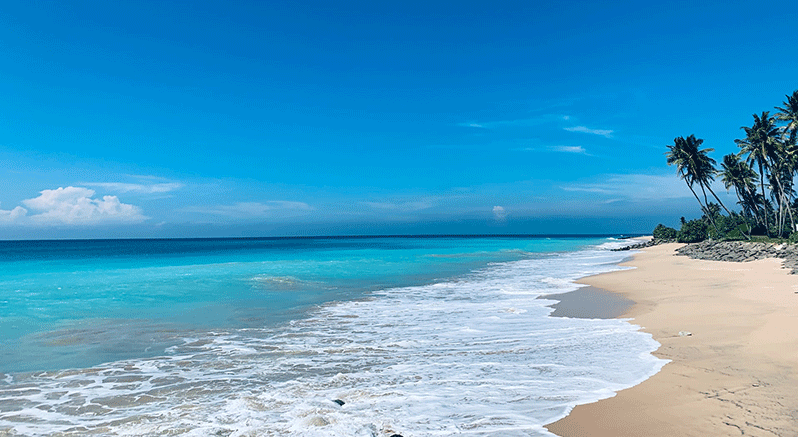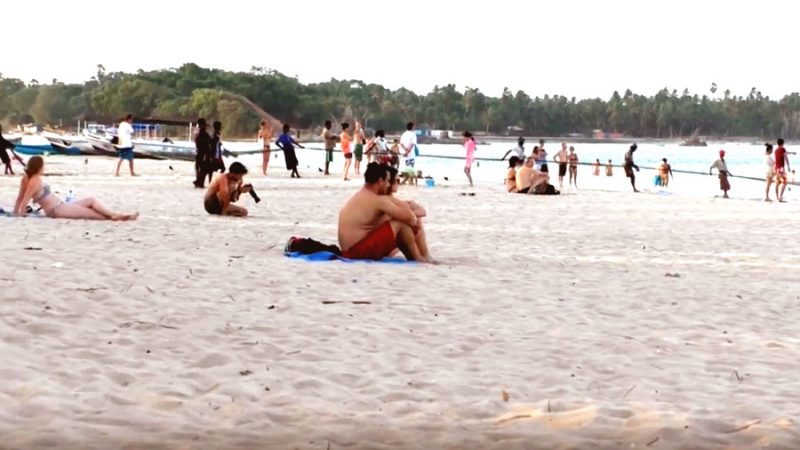Sri Lanka’s Buzzing Emerging City Trincomalee
Sri Lanka’s Buzzing Emerging City Trincomalee
Bentota, Kandy and Colombo in the bucket list of every traveller, but only one in 10 come across the vibrant, buzzing city of Trincomalee in the eastern coast of Sri Lanka.
In 2006, the government of Sri Lanka withdrew from the peace deal, which signed with rebels, and started to attack rebels in order to get the control of North-East Sri Lanka, which was unofficially governed by the rebels for 30 years. After nearly three years of the successful campaign (2009), the government forces were able to abolish the unofficial authority of the rebels in the region.

The island was visited about 500,000 tourists a year during the 30 years war on the island, the number of foreign visitors on the island was constantly on the rise since the end of the war, last year number of travellers on the island was recorded as 2 million, up from only 500,000 a decade ago. And while the places such as Bentota, Galle, Colombo and Kandy in the list of must-visit places for every traveller, only one in 20 visits Trincomalee or Trinco for short, a vibrant, hot, buzzing city of nearly a half a million in the district of Trincomalee, in the country’s east.
Eastern Sri Lanka, you see, suffers a bad image as an underdeveloped part of Sri Lanka perpetuated by news shown to the world during the war. From 1983 to 2009, Trinco was among the most dangerous cities in the world-hot bed of abduction, bombs, guns, drugs, and violence.
After 2009 crime is not a problem in Trinco anymore, and the civil rule was fully implemented and Trinco has been transformed into one of the most peaceful neighbourhoods on the eastern Sri Lanka, where thousands of Buddhist and Hindu monuments makes it an inevitable destination of travel.
Trinco is another city with widespread beachfront, and has one of the biggest natural deep-water harbours in the world, which can accommodate big vessels; Trinco has a unique culture, history and flavour. Starting from the Portuguese colonial period (1505-1656), the harbour of Trincomalee played an important role in the country’s spice industry, Trinco was the home to one of the main storehouse of spices before shipped to Europe through the Trinco port.
The history of Trinco is very controversial and vague due to the lack of historical notes on the region. Unlike other historical places in Sri Lanka such as Anuradhapura, Polonnaruwa, Sigiriya rock, Dambulla cave temple Trinco is deprived of concrete evidence to prove it’s important in the past.
Nagadeepa Buddhist temple, which is one of the most popular pilgrimage sites, of the north of Trincomalee, is believed to be a place, where Buddha presented himself in 3rd century BC. During the archaeological excavations, several ancient Buddhist temples were discovered in Trinco, most recent such finding was a temple near the hot wells in Kinniya, so it suggests that the Buddhism had been a widespread Religion in the country including in the past East coast.
Places to visit in Trincomalee
Trincomalee and the East coast of the island is a major holiday destination in Sri Lanka. Kinniya hot wells that is located 10 km from Trincomalee is one of nature’s wonders gifted by the island. There are 8 major wells with thermal water, each well has its own identical temperature many believe that it has curative features for certain ailments.
Six kilometres from Kinniya, amidst thick jungle, the oldest Buddhist temple in Trincomalee, “Wilgamvehera”, and the road is narrow up to the temple which is around two and a half kilometres. Wilgamvehera is a vast complex of the ruined monastery, stretching far and wide into the jungle.
It is said to have been built by King Devanampiyatissa, the pioneer Buddhist King of Sri Lanka 2250 years ago and the “Wilgamvehera” stone inscription written in Tamil, reveals that real coexistence, prevailed among the Sinhalese and Tamils in the past. The neatly kept compound is an added beauty to this sacred place.
Trincomalee Nilaveli beach
Nilaveli is one of the most beautiful beaches in Sri Lanka and it is 13 kilometres from the city of Trincomalee. A large number of sun-worshippers arriving in Sri Lanka, especially from April to November is heading to this fascinating village by the sea. One can see the unpleasant memories of the war that existed in the area. Tourist is now heading to the Nilaweli beach to enjoy their beach holiday in Sri Lanka, it has already become an active holiday destination after the civil war.
The tourists have started to flock to the beaches of Nilaveli since the improved security in the area. Several large-scale hotels are being built to accommodate high-end holidaymakers in the area. There are plenty of accommodation facilities for tourists in Nilaveli and there are large numbers of small guest houses and hotels are opened during the last few years in the wake of increasing accommodation demand.
The distance from Colombo to Nilaveli is 271 km and can be reached via Anuradhapura or Habarana, Nilaweli is one of the prime beach resorts on the east coast of Sri Lanka. Nilaveli is ideally suited for sunbathing and diving. A few meters from the coast is a small rocky island known as pigeon island, which very is good for snorkelling. Nilaveli is surrounded by many important historical and religious places mentioned in this post such as Thiriyaya Buddhist temple, Kinniya hot wells, Lowers leap, Trincomalee harbour and fort and Thirukoneswaram Hindu temple.
Nilaveli is a severely affected area by the 30 years war and it was severely damaged by the Tsunami in 2004. Today most of the people are in utter poverty and most of them are lack of basic facilities. The area is dominated by Hindu Tamil and catholic Tamil communities.
There is also a sizable population representing Sinhalese and Muslim ethnic groups. Being a beach resort at the tip of the east coast Nilaveli categorized as an area with hard climate conditions. The heat of the area is very high compared to the west or south coast of Sri Lanka. The dryness prevails during most part of the year and monsoon rain pours the water during the months of November, December and January.
When is the best time to travel to Nilaveli, Sri Lanka
The best travel time to the Nilaveli beach is from April to October while dry weather dominates in the west and southern coast from November to April.
Agriculture and fishing are the most important income-generating industries for the people in the area. Both income methods are highly seasonal and the people are lack of activities out of the season. Fishing industry comes to live in April with the ending of Monsoon and fisherfolk from other parts of the country are also migrating to this part of the country.
During the monsoon the sea is rough and the fisherfolk stay away from the sea. Vegetables such as manioc, onion, ladies fingers and coconut are the most important crops for the people here. Especially the onion is grown here far better than anywhere else in the country.
One major setback for the development in the area is recognized as the lack of job opportunities for the people. Therefore the jobless rate among people tends to be high. The upcoming giant hotels along the coast of Nilaveli believed to be a good solution for the jobless people here.
The infrastructure facilities such as schools, hospitals, childcare services believed to be inadequate here. But the government of Sri Lanka and various other non-governmental organizations have spent a large amount of money to improve the living standard of the community and various other projects are underway. Most important infrastructure facilities such as roads, bridges, electricity and water supply are back to normal in many parts of Nilaweli with the “Negenahira Udanaya” program launched by the government.
After several years of the last face of the war, a sizable improvement of civil life can be witnessed in Nilaveli. People who fled the area during the troubled period are returning to their traditional homelands. A large number of construction activities can be seen in the area and which is a sign of fast recovery from the destruction.
Trincomalee town
When compared with other major cities of Sri Lanka, Trincomalee town is a somewhat backward one. Proper town planning has not been carried out during the war, so as a result the outlook of the town not an eye-catching one to the visitors.
But, the area belongs to Fort Fredric and their environs are very beautiful, view from the summit of the Swamy Rock over the Indian Ocean is magnificent. Seruwila that built 2250 years ago by King Kawantissa is located in Eastern province. It is one of the most venerated historical temples in the island.
The forehead bone of Buddha is said to be enshrined in the dagoba. Numerous ruins of great stone structure and to be seen here and there, some partly covered by the encroaching jungle. When permanent peace is restored, this holy place will be an important one for all Sri Lankan Buddhists.
The beauty of the Kantale tank magnifies the last rays of the preceding day, by watching this an ancient man-made reservoir, I felt a subtle sadness of our glories and present predicament.
There are well known 2 natural harbours in the island of Sri Lanka; Trincomalee and Galle. Trincomalee considered being one of the deepest natural harbours in the world and used by the ancient seafarers 2500 year ago. The strategic location of the harbour proved to be one of the most important places in Asia during World War 2.
European powers calculated that whoever controls the Trincomalee harbour, have the better chance of controlling the Eastern part of India. Trincomalee harbour was controlled by four colonial rulers in the past Portuguese, Dutch, French and English. Under the British control from 1795 to 1848, it was harbour was improved to accommodate bigger vessels.






